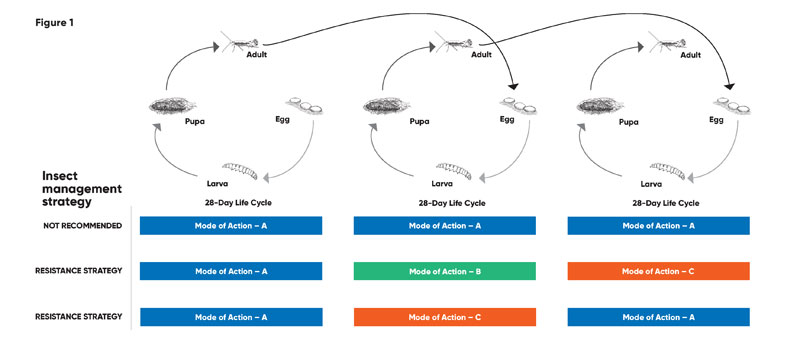2/1/2023
Get With the Program
Broch Martindale

An integrated pest management (IPM) program approach should be part of everyone’s strategy when controlling pests and diseases in greenhouses and nurseries. Before building a program,
it’s best to understand what causes insecticide resistance and how you can control it.
Insecticide resistance
Insecticide resistance can occur over time when various biological, genetic and operational factors increase the selection pressure on an insect population. This results in the decreased susceptibility of an insect population to an insecticide that previously controlled that population of insects (e.g., the insecticide no longer provides the expected level of control of the insect population). The potential for resistance is particularly high in a greenhouse setting where:
1. Constant environmental factors and low beneficial predator/pest populations favor a highly uniform pest population
2. Robust spray programs exhibit powerful selection pressure in favor of individuals with genes for resistance
Insecticide resistance management (IRM) helps to prolong the effectiveness of insecticides and is a shared responsibility among manufacturers, formulators, distributors, retailers, universities, the government and growers.
When using multiple modes of action, insecticide mixtures may offer benefits for IRM when incorporated into rotation strategies. According to the Insecticide Resistance Action Committee (IRAC), when using an insecticide mixture (tank mixture or premixture), the following aspects should be considered:
• Individual insecticides selected for use in mixtures should be highly effective and be applied at the rates at which they’re individually registered for use against the target species.
• Mixtures with components having the same IRAC mode-of-action classification aren’t recommended for IRM.
• When using mixtures, consider any known or potential cross-resistance of the target pest(s) to the individual components of the mixture.
• Mixtures become less effective if resistance is already developing to one or both active ingredients. However, they may still provide pest management benefits based on the spectrum of the targeted insects.
• The IRM benefits of an insecticide mixture are greatest if the two components have similar periods of residual insecticidal activity. Mixtures of insecticides with unequal periods of residual insecticidal activity may offer an IRM benefit for the period where both insecticides are active.
Ornamental plants in greenhouses and nurseries are considered short-cycle crops and have shorter treatment windows. Effective resistance management for these short-cycle crops includes rotating insecticide products with different modes of action to avoid treating successive generations of the same pest with the same mode of action (Figure 1).
By adhering to this rotational strategy, the selection of insecticide products remains an effective insect control tool for the future. With the long process of discovering new chemistry and introducing an effective insecticide to market, ignoring IRM strategies may limit effective insect control options in the future.
The most effective resistance management strategy is the prevention of insecticide resistance. Utilizing products with different modes of action, such as those in the Corteva Agriscience Turf & Ornamental portfolio, is an excellent way to start your insect management program in greenhouses and nurseries.
Developing the program
Why are rotational programs more difficult to develop and understand? There have been several new classes of chemistry with different modes of action developed in the last 10 to 15 years. These new classes of chemistry include insect growth regulators (IGR) that can be a valuable tool when putting together a program for your facility. Newer pesticides are more targeted toward both insect species and life stage than before, so knowing the pest is even more important.
Important components
• Scouting and pest identification before and after insecticide application.
• For insects with multiple or overlapping generations, use a treatment window approach,
• Applications should target the early or most susceptible insect stage,
• Insecticide mixtures may offer IRM benefits when used in a rotation strategy.
Insecticide mixture considerations
• Mixtures provide technical advantages for controlling pests, including increased spectrum and level of targeted pest control.
• Individual insecticides should be highly effective and applied as prescribed.
• Mixture components with the same IRAC mode-of-action classification aren’t recommended for IRM.
• Consider cross-resistance issues among the individual components for the targeted pest(s).
• IRM benefits are greatest if components have similar residual activity.
For more specific information, please read and follow the label for important resistance management requirements and strategies.
Resources for resistance management
IRAC (www.irac-online.org) has a wealth of information and resources to manage insecticide resistance:
• HRAC (herbicide resistance)—www.hracglobal.com
• FRAC (fungicide resistance)—www.frac.info

Corteva Agriscience Turf & Ornamental portfolio
Discover how the Corteva Agriscience Turf & Ornamental portfolio of products can help you protect and preserve what you grow while helping you maximize the labor you have.
With its rich heritage of Dow AgroSciences, DuPont and Pioneer that includes more than two centuries of scientific achievement, Corteva is committed to enriching lives with solutions that address the needs of producers and growers.
The best-in-class safety our products provide is backed by rigorous research and testing to ensure efficacy, as well as plant health and safety.
An IPM approach includes:
• Working with crop experts
• Monitoring pests in the field
• Using economic thresholds to determine when to treat pest populations
• Selecting control measures that consider the impact on future pest populations
An IPM strategy includes:
• Using labeled application rates and spray intervals
• Avoiding the use of insecticides with the same mode of action on succeeding generations of an insect
• Targeting the most susceptible life stages of an insect
• Preserving beneficial insects
Broch Martindale is National Greenhouse & Nursery Strategic Account Manager for Corteva AgriScience. He can be reached at broch.martindale@corteva.com.
Visit corteva.us/nursery to learn more.
™ Trademarks of Corteva Agriscience and its affiliated companies. Always read and follow label directions. © 2023 Corteva.